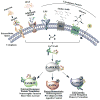The Ca(2+)/Calmodulin/CaMKK2 Axis: Nature's Metabolic CaMshaft
- PMID: 27449752
- PMCID: PMC5035586
- DOI: 10.1016/j.tem.2016.06.001
The Ca(2+)/Calmodulin/CaMKK2 Axis: Nature's Metabolic CaMshaft
Abstract
Calcium (Ca(2+)) is an essential ligand that binds its primary intracellular receptor calmodulin (CaM) to trigger a variety of downstream processes and pathways. Central to the actions of Ca(2+)/CaM is the activation of a highly conserved Ca(2+)/CaM kinase (CaMK) cascade that amplifies Ca(2+) signals through a series of subsequent phosphorylation events. Proper regulation of Ca(2+) flux is necessary for whole-body metabolism and disruption of Ca(2+) homeostasis has been linked to various metabolic diseases. Here we provide a synthesis of recent advances that highlight the roles of the Ca(2+)/CaMK axis in key metabolic tissues. An appreciation of this information is critical to understanding the mechanisms by which Ca(2+)/CaM-dependent signaling contributes to metabolic homeostasis and disease.
Keywords: AMPK; CaMKIV; CaMKK2; calcium; calmodulin.
Copyright © 2016 Elsevier Ltd. All rights reserved.
Figures




Similar articles
-
Research Resource: Roles for Calcium/Calmodulin-Dependent Protein Kinase Kinase 2 (CaMKK2) in Systems Metabolism.Mol Endocrinol. 2016 May;30(5):557-72. doi: 10.1210/me.2016-1021. Epub 2016 Mar 22. Mol Endocrinol. 2016. PMID: 27003444 Free PMC article.
-
Functional analysis of an R311C variant of Ca2+ -calmodulin-dependent protein kinase kinase-2 (CaMKK2) found as a de novo mutation in a patient with bipolar disorder.Bipolar Disord. 2020 Dec;22(8):841-848. doi: 10.1111/bdi.12901. Epub 2020 Apr 9. Bipolar Disord. 2020. PMID: 32216002
-
AMP-activated protein kinase-mediated feedback phosphorylation controls the Ca2+/calmodulin (CaM) dependence of Ca2+/CaM-dependent protein kinase kinase β.J Biol Chem. 2017 Dec 1;292(48):19804-19813. doi: 10.1074/jbc.M117.805085. Epub 2017 Oct 3. J Biol Chem. 2017. PMID: 28974582 Free PMC article.
-
Calcium/calmodulin-dependent protein kinase kinase 2: roles in signaling and pathophysiology.J Biol Chem. 2012 Sep 14;287(38):31658-65. doi: 10.1074/jbc.R112.356485. Epub 2012 Jul 9. J Biol Chem. 2012. PMID: 22778263 Free PMC article. Review.
-
Molecular Mechanisms Underlying Ca2+/Calmodulin-Dependent Protein Kinase Kinase Signal Transduction.Int J Mol Sci. 2022 Sep 20;23(19):11025. doi: 10.3390/ijms231911025. Int J Mol Sci. 2022. PMID: 36232320 Free PMC article. Review.
Cited by
-
Microglia in Alzheimer's disease: pathogenesis, mechanisms, and therapeutic potentials.Front Aging Neurosci. 2023 Jun 15;15:1201982. doi: 10.3389/fnagi.2023.1201982. eCollection 2023. Front Aging Neurosci. 2023. PMID: 37396657 Free PMC article. Review.
-
Cdo1-Camkk2-AMPK axis confers the protective effects of exercise against NAFLD in mice.Nat Commun. 2023 Dec 18;14(1):8391. doi: 10.1038/s41467-023-44242-7. Nat Commun. 2023. PMID: 38110408 Free PMC article.
-
The role of TRPV1 ion channels in the suppression of gastric cancer development.J Exp Clin Cancer Res. 2020 Oct 2;39(1):206. doi: 10.1186/s13046-020-01707-7. J Exp Clin Cancer Res. 2020. PMID: 33008449 Free PMC article.
-
MicroRNA-219 alleviates glutamate-induced neurotoxicity in cultured hippocampal neurons by targeting calmodulin-dependent protein kinase II gamma.Neural Regen Res. 2018 Jul;13(7):1216-1224. doi: 10.4103/1673-5374.235059. Neural Regen Res. 2018. PMID: 30028330 Free PMC article.
-
CaMKK2 in myeloid cells is a key regulator of the immune-suppressive microenvironment in breast cancer.Nat Commun. 2019 Jun 4;10(1):2450. doi: 10.1038/s41467-019-10424-5. Nat Commun. 2019. PMID: 31164648 Free PMC article.
References
-
- Chin D, Means AR. Calmodulin: a prototypical calcium sensor. Trends in cell biology. 2000;10:322–328. - PubMed
-
- Means AR, Dedman JR. Calmodulin--an intracellular calcium receptor. Nature. 1980;285:73–77. - PubMed
-
- Clapham DE. Calcium signaling. Cell. 2007;131:1047–1058. - PubMed
-
- Berchtold MW, Egli R, Rhyner JA, Hameister H, Strehler EE. Localization of the human bona fide calmodulin genes CALM1, CALM2, and CALM3 to chromosomes 14q24-q31, 2p21.1-p21.3, and 19q13.2-q13.3. Genomics. 1993;16:461–465. - PubMed
Publication types
MeSH terms
Substances
Grants and funding
LinkOut - more resources
Full Text Sources
Other Literature Sources
Miscellaneous

